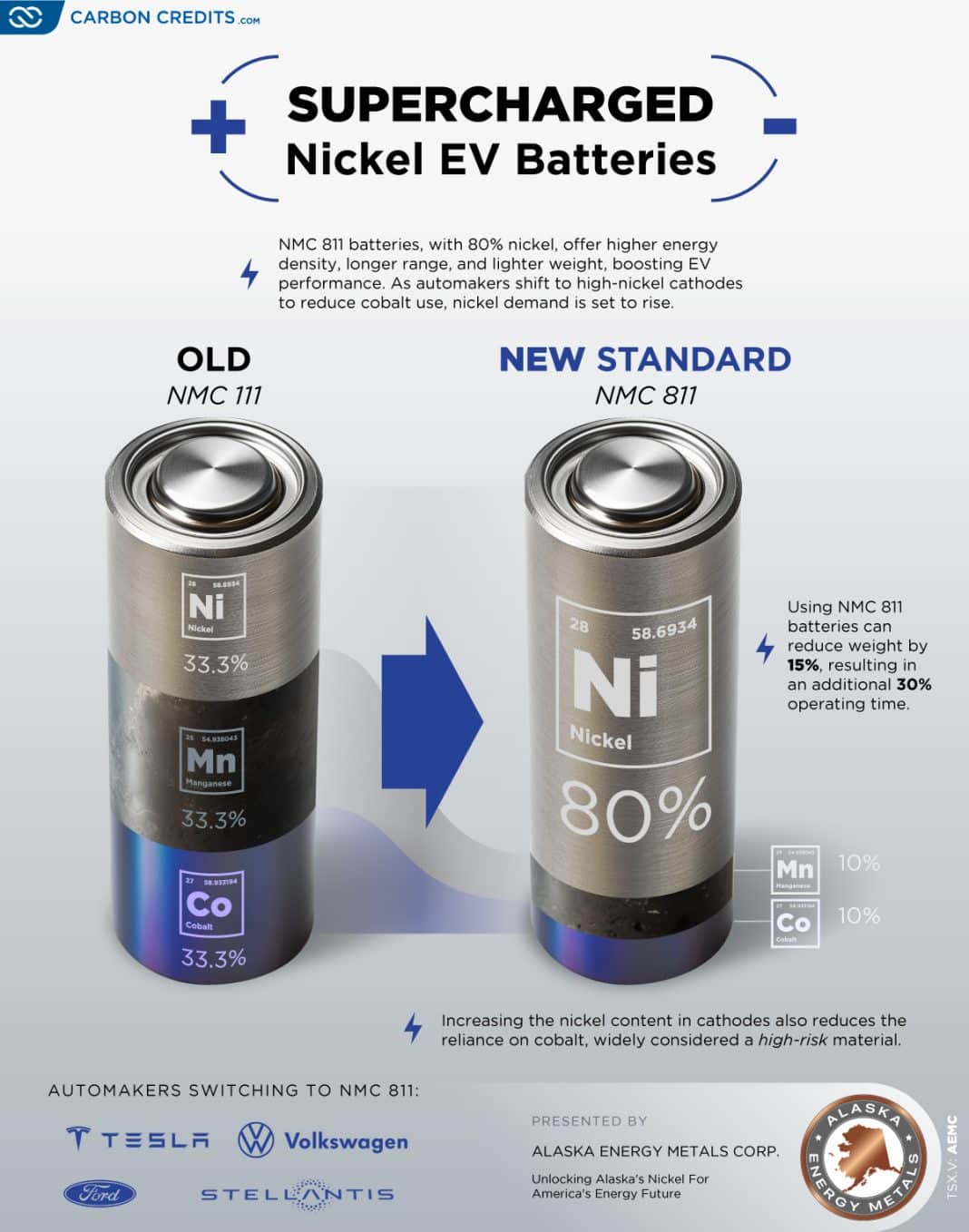Disseminated on behalf of Alaska Energy Metals Corporation (AEMC).
As automakers prioritize energy efficiency and sustainability, nickel-rich batteries are becoming essential in the electric vehicle (EV) market. This silvery-white metal is now one of the most coveted elements for high-performance batteries that can power the future of electric mobility.
In this nickel revolution, high-nickel cathodes, such as those in NMC 811 batteries are taking the lead. These batteries offer higher energy density, reduced weight, and extended driving ranges which are vital consumer needs.
To name a few, top EV brands like Tesla, Volkswagen, Ford, and Stellantis are betting on NMC 811 batteries. Notably, these batteries reduce reliance on cobalt- a high-risk material, making them a more sustainable and cost-effective choice for the EV industry.
The Rise of NMC 811: Old vs. New
Traditional NMC 111 batteries rely on equal parts nickel, manganese, and cobalt. In contrast, the new standard—NMC 811—packs 80% nickel, cutting cobalt and manganese usage to just 10% each. This shift brings some powerful benefits to the new generation batteries:
- 15% weight reduction
- 30% longer battery life
- Improved energy density and range
These upgrades not only enhance EV performance but also align with sustainability goals by reducing dependency on cobalt.
So, What Sets NMC 811 Batteries Apart?
The latest generation of NMC 811 batteries differs significantly from earlier versions, thanks to advancements in their composition.
- Increased Nickel Content: The 8:1:1 ratio in NMC 811 refers to a higher proportion of nickel compared to cobalt and manganese. This shift enhances energy density, allowing EVs to travel farther on a single charge.
- Cobalt Reduction: By minimizing cobalt content, these batteries reduce supply chain risks and improve affordability without sacrificing performance.
- Lighter and More Efficient: Lightweight and longer battery life make them energy efficient for EVs, thereby contributing to better overall performance and lower energy consumption.
The Future of Nickel: Surge in Demand with Battery Innovation
We have seen and read earlier that battery nickel demand has faced challenges in 2024 mainly due to weak EV sales in Western markets. However, despite these short-term setbacks, the long-term outlook for nickel appears highly promising. Projections suggest that demand for battery-grade nickel will grow by 27% year-on-year in 2024, highlighting its critical role in the EV revolution.
- According to the Benchmark Nickel Forecast, batteries will drive over 50% of nickel demand growth by 2030, with consumption expected to reach 1.5 million tons by the decade’s end.
This growth reflects the increasing reliance on nickel-based chemistries, which are expected to dominate sustainable battery manufacturing. The Benchmark analysis also shows that such prototypes will account for 85% of battery cell production capacity outside China by 2030.
Thus, it seems inevitable that high-nickel chemistries, precisely the NMC 811 batteries will be the key driver for nickel demand and represent a significant breakthrough in the EV industry.
MUST READ: Nickel Could Be the Key to U.S. Energy Independence: Alaska Energy Metals’ Strategic Role
FEATURED: Live Nickel Prices
Disclosure: Owners, members, directors, and employees of carboncredits.com have/may have stock or option positions in any of the companies mentioned: AEMC.
Carboncredits.com receives compensation for this publication and has a business relationship with any company whose stock(s) is/are mentioned in this article.
Additional disclosure: This communication serves the sole purpose of adding value to the research process and is for information only. Please do your own due diligence. Every investment in securities mentioned in publications of carboncredits.com involves risks that could lead to a total loss of the invested capital.



